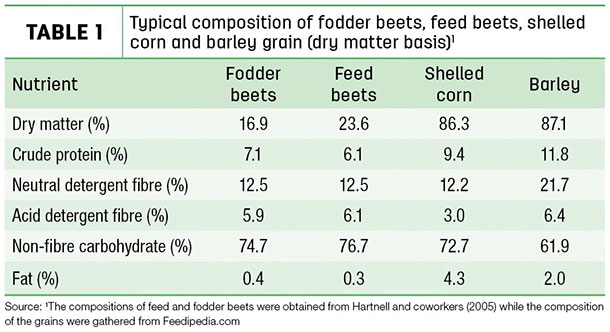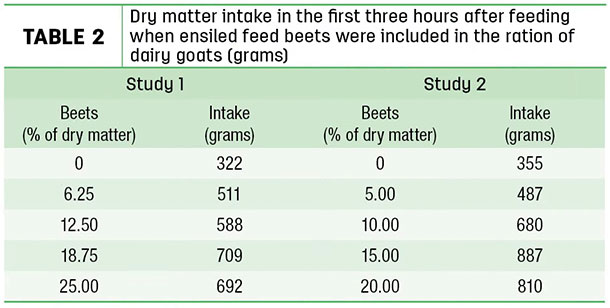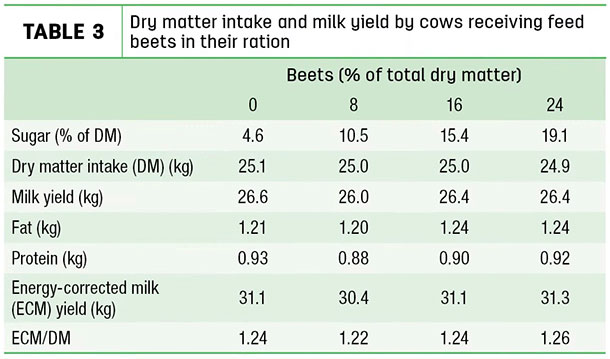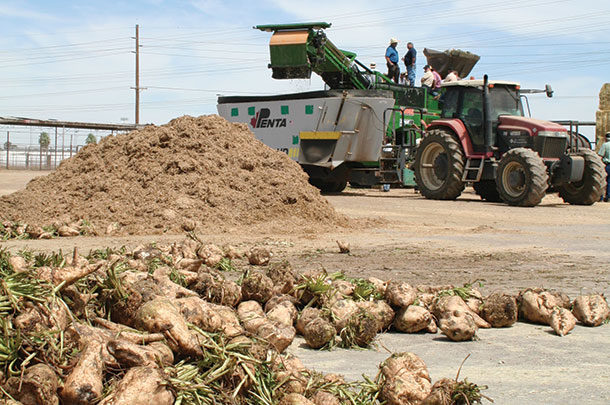Feed beets are sugarbeets grown specifically for use in feed for dairy and beef cattle as an economical substitute for grains.
Dry matter yields are quite a bit higher than corn grain, and cost per acre to produce feed beets is about the same as that of corn.
In addition to their economic value, sugarbeets are a drought-resistant, sustainable crop that helps to loosen soil and can be grown in many soil types.
Feed beets are also versatile feed ingredients. They can be fed fresh (they store well in piles) or ensiled and can even be chopped and included in other ensiled feeds, such as haylage or corn silage. However, because of their high moisture content, they are best used locally.
The nutritional value of feed beets becomes obvious when compared to other concentrate ingredients, as Table 1 illustrates.

Although the composition is similar to the fodder beets that are so common in some parts of the world, feed beets have a higher dry matter content. This is an advantage when feeding because the ration is less bulky with feed beets.
Fibre and non-fibre carbohydrate (sugars and starch) concentrations are similar to corn grain; however, the fat is quite a bit less with feed beets. Feed beets have less fibre and more non-fibre carbohydrates than barley.
The factor that differentiates beets the most from corn and barley is the fact that beets contain mostly sugar, not starch. Some nutritionists have been hesitant to replace larger amounts of starch in the diet with sugar for fear it might result in lower rumen pH levels, which could lead to acidosis.
However, in a very thorough review published in 2011, Dr. Masihito Oba from the University of Alberta concluded this is not the case. Rumen pH is not lower with sugar than it is with starch.
Also, because cows eat their ration in meals throughout the day, their intakes of sugar as well as starch are spread out and have less impact than if the sugar was fed all at once.
One important benefit feed beets provide is great palatability. Many studies have shown cows prefer diets that are sweet over diets that are salty, bitter or sour.
In a recent study conducted by Dr. Katrin Gerlach and others, dry matter intakes (DMIs) increased as the percentage of ensiled beets was increased in diets for dairy goats (Table 2).

Cows have also been found to have a sweet tooth, and sugars are a natural part of dairy diets. Many ingredients, such as hay, grain and pasture grasses, contain sugars.
There are also a number of well-accepted byproduct ingredients that contribute sugar, such as molasses whey, lactose and beets.
At the 2017 Tri-State Dairy Nutrition Conference, Dr. Mary Beth Hall, who works at the USDA Forage Research Center in Madison, Wisconsin, reported that not all sugars are alike.
There are simple sugars (monosaccharides), such as glucose and fructose, as well as disaccharides that are made up of two sugar units, such as sucrose and lactose. The disaccharides may be digested more slowly than the monosaccharides by rumen microbes.
Rather than converting the sugars to fermentation acids, rumen microbes can use some to form glycogen and store that in their cells. The glycogen then leaves the rumen with the microbial protein.
This means there is less converted to acids. Hall noted rumen pH is more likely to stay the same or even increase when sugars are substituted for starch.
Dr. Jeff Firkins of Ohio State University provided another interesting perspective. The fermentation of sugars can result in higher rates of production of butyric acid. This acid is used by the rumen epithelium and supports the health of this organ.
Much of the research about using sugar in place of starch is quite recent, and we are learning how sugars work to potentially improve health and improve DMI. However, there are still some studies where large amounts of sugar have been included in the diet.
In a recent beef feeding trial conducted by Dr. Vern Anderson at North Dakota State, growing cattle were given diets containing 26% sugarbeets (feed beets) in place of corn silage.
This provided approximately 19% sucrose. Average daily gains (ADGs) were higher (1.98 versus 1.83 kilograms per head per day) with the high-sugar diet.
Feed beets were also used to increase sucrose in diets for dairy cows. In a study reported in The Professional Animal Scientist, researchers at the Atlantic Dairy and Forage Institute (Evans and associates) determined mid-lactation dairy cows produced just as much milk with sugar as with starch in the ration (Table 3).

The cows were given diets that contained 0%, 8%, 16% or 24% of the total dry matter as sugarbeets. The sugarbeets were substituted for the grain mix, which was composed of corn and barley.
There was no loss in milk yield, milk components or feed efficiency as the amount of beets in the diet increased. The barn staff noted the cows looked forward to the feed beets, and there were no health issues or problems at all.
There is still a lot to learn about feeding sugar to dairy cows; one lesson that can be taken to heart is that sugar does not need to be restricted to the extent previously thought when it is mixed in rations.
Feeding up very high levels of feed beets, such as 24% of dry matter, may not be practical. However, substituting part of the grain in a typical ration can improve diet palatability and can improve farm profitability. ![]()
References omitted but are available upon request. Click here to email an editor.
PHOTO: Feed beets are versatile feed ingredients. They can be fed fresh, ensiled or chopped and included in other ensiled feeds, such as haylage or corn silage. Photo by Walt Cooley.

-
Essi Evans
- Technical Advisory Services Inc.
- Email Essi Evans









